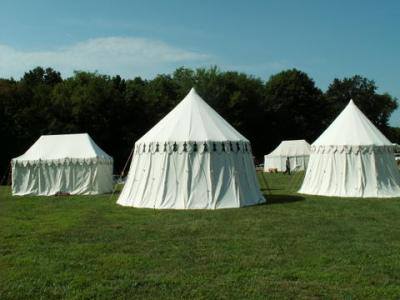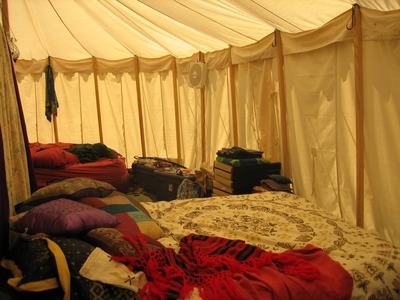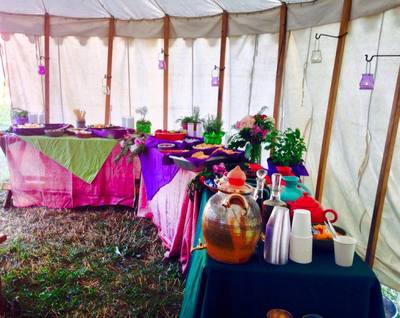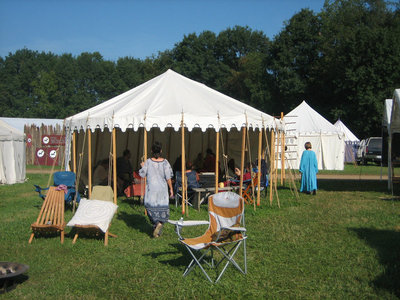 Regent tent belonging to a camp mate.
Regent tent belonging to a camp mate.
I want to state upfront that I am a die-hard fan of Panther Primitives Tents. They are not the only tent maker out there these days, and while I have heard mostly good things about companies like Midwest tents, I have also seen some other pavilions from other companies that made me cringe (seriously, nothing should be STAPLED together on a tent). So yes, I am definitely a fan of Panther, and should I ever buy another tent, it is guaranteed to come from there. Even if you are buying a tent elsewhere, some of my comments about tent styles might still be of benefit to you. ( http://www.pantherprimitives.com/ )
My first tent, which I do not have a picture of at the moment, was actually a Wall Tent. This was left over from my days as a Civil War reenactor and my then-husband portrayed an officer, we had a wall tent rather than a wedge. I actually have no faults with this tent or this style. If you use the style that has only a ridge and end poles, the length of ropes you need to stretch out the walls can take up excessive space in camp, so that is something one needs to consider. These do, however, tend to have a good deal of usable space inside, and front and back doors make for good air circulation.
The second tent I used was one I borrowed, and that was 16X16 Regent. We actually used to have quire a few of these in our camp (both the 16X16 and the 12X12) size. I like these for their portability as they have very few poles involved. You lose floor space due to slanted walls and the clipped corners, but the 12X12 is particularly awesome for single people who might not need to put a large bed inside. They go up pretty easy, but I prefer setting one up when there are at least 4 people to help manage it. The walls are attached which means that the person holding poles inside might bake a bit while everything is set up. But as a hole, I find them to be attractive and functional. They are also nice in that you can get a fly on the front as well to help with sun.
 Carousel structure (photo from Panther catalog)
Carousel structure (photo from Panther catalog)
One of the benefits is that you can actually use the spoke system to hang light weight items like a few garments or your lanterns. The only other benefit is that they look good. They look really good. This is what my brain imagines all medieval tents looked like. The major drawback though, is that the large sized ones always seem to have the top blow out after about 5 years, even with careful maintenance. There is a great deal of weight on the top of that pole. In a single year at Pennsic, I knew of 4 or these that ripped through. One happened when folks in my camp were there to see it go. They heard the pop and then the entire tent slowly deflated and shuddered to the ground.
- Seam Engineering - Never, ever again. I understand the benefits (which are described in detail on page 16 of Panther's catalog), but I hate it. In addition to decreasing the tent size from 18X18 to 16.5X16.5, it places the poles closer together. They are just tight enough that I cannot walk through the opening while carrying a cooler (and I am not a big person). It also means there are MORE poles to drag around with you.
- 7ft Walls - The tents in camp with 6ft walls can have the stakes set in just a bit closer than those with 7ft walls, which means it is more stable while taking up less space. In years when we were crammed in tightly, my stakes were always a bit too close and I had to go out and fuss with them daily. (This was also an issue with the Oval Marquee.) If I ever got another marquee, it would have 6ft walls and anyone taller can just duck.
- Single pole - This, at large sizes, could have the same issues over time as the Carousel Pavilion did, with the pole tearing through the roof if the webbing at the top happens to go. I know people like this option because it leaves more space inside for large beds and the like. If I got another tent like this, it would use a ridge pole with two supports. The tents with single poles in our camp (which sits on a slight slope, which means that tents are never totally level) tend to have more water collect in the corners during a storm than those with ridge poles do.
 The inside of my tent. This is before I switched from the A frame closet, which did not work well on our slope, to one suspended from the ridge. There is ample space to move around and store things with either closet set up.
The inside of my tent. This is before I switched from the A frame closet, which did not work well on our slope, to one suspended from the ridge. There is ample space to move around and store things with either closet set up.
Finally, we arrive at my current (and very much loved) set-up, the Norman Saxon Tent. I will admit that I resisted this idea for years. My boyfriend suggested these over and over and I was very worried about about all the things I heard about all of the things I have heard about not having any space in these things. He bought one for himself, and after a year of him using that and my friends and I using the Marquee, I realized he was correct and he got me one as well.
We use one wedge for small events, or even occasionally for mundane camping and there is plenty of space for a queen sized bed and our gear, as well as a chair in the front for him. For Pennsic, we often are moving around at different hours (and he likes to take naps), and plus I bring a ton of stuff (class materials and garb, garb, garb) so we take two and set them up side-by-side.
This style of tent goes up quickly. I am not strong enough to lift the ridge, but I can roll out the tent and stake everything down, get a few hands to insert the ridge and lift the roof and then I can finish on my own from there. The whole thing can go up in less than 20 minutes.
There is also plenty of room in there for me for War, despite the amount of things I take. I have a cot that is bigger than a twin bed and nearly as tall, a small dresser and a cooler. I have tons of very large bins that get shoved against the walls in the back half of the tent and I have rigged a small closet rod (which I will post about later at some point) that hangs from the ridge in the very back of the tent for my garb. Honestly, there is more than enough space for me, even with my excess of stuff. In the center photo below you can see his tent set up as vigil tent a few years ago. The cot in the back is a tall XL cot and there was enough room to have it running across the width of the tent rather than the length.
Another comment I want to make about the wedge tents is that they require zero maintenance once they are set up. With a marquee or regent you will usually need to adjust the ropes several times during a long event (sometimes even daily). These require no effort at all. We also have had his wedge tent set up on a mundane camping trip that had 60mph wind gusts and it never leaked nor budged. They are very solid beasts.
A note about Ground Cloths. This is a very contentious item on some of the forums. People love them, hate them, have other alternatives, you name it. I will note that we have the Panther Super Ground Cloth for each of our tents. I personally love them. This is a canvas cloth that is cut to the size of your tent and has a plastic tarp sewn to the bottom. Having the correct sized floor is very important to properly set up tents like the wedges, which can be staked to the ground before raising the roof. The tarp on the bottom means that I don't have to carry an extra tarp (though some people do). These last a very long time, and we take care to fold them so that none of the canvas floor touches the icky damp tarp portion when packing-out from Pennsic. When I get home I lay them out on the pavement in the drive way, tarp side up, and bake off all the gross stuff in the sun, sweep it clean and then flip it over to bake some more (and ensure it is totally dry).
There are two companies that make very similar canvas tents, Springbar and Kodiak. Friends of ours have several Springbar tents, and when we were looking for a more portable option (that was not nylon) to using our wedges for mundane camping, we decided to test drive the Kodiak. I have to say that I love these tents. The components come in two bags, one for the poles and one for the tent. This means that I can carry these items myself as separately they do not weigh overly much. My boyfriend could set one up by himself, but I need help to raise the ridge (the same as I do with the wedge). They go up in mere minutes and take up little space in the car compared to a pavilion. If you are on a tight budget and cannot afford a pavilion yet (or if you have space constraints such as apartment living), something like this might be the best option for you. The Kodiak tent we have even has an adorable little built in sun shade on the front, and there are accessories for inside that allow you to store some things up near the ceiling. I cannot recommend these tents enough for those who can not yet make the commitment to a period tent.
There is plenty of headroom in all of these options, and the bow sides mean that you have less of a slant and less wasted floor space. The bottom of the Kodiak is very heavy vinyl that keeps water out and we have never had an issue with the tent leaking else where either. We do use a small tarp under this, because you cannot as effectively bake the bottom of the tent the way you do with a Panther Super Ground Cloth.
We have the "8 Person" 10X14 foot Kodiak. There is a couple in our camp that has one as well and it is more than sufficient for them for Pennsic (and more comfortable than their previous nylon tent). I do not know that I would consider going smaller, but they do have other sizes as well, including a 10X10. (There is also a cabin tent style that I do not recommend if you want fast set up. They are really neat in terms of the shape and size, but take much longer to set up than the flex-bow design of the tents we have.)
10X14 Options
|
|
|
10X10 Options
|
|
|
A Wandering Elf participates in the Amazon Associates program and a small commission is earned on qualifying purchases.














 RSS Feed
RSS Feed